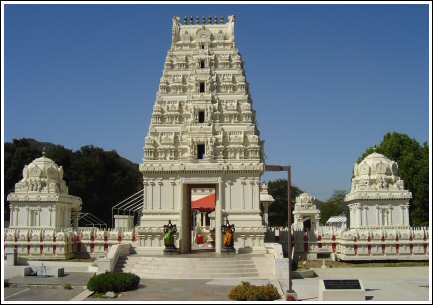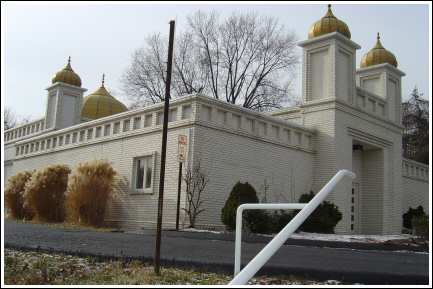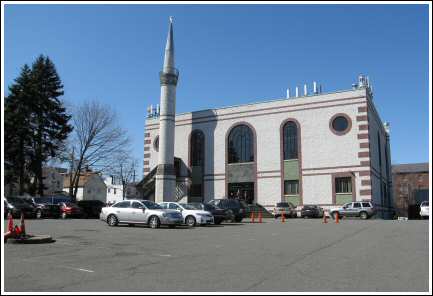It’s safe to assume that the majority of people of Indian origin living in the United States are either Hindus, Sikhs or Muslims.
After all, these three religions account for about 97% of India’s population.
And most people of Indian origin in America have come primarily from India (along with small numbers from Uganda, UK, Surinam, Trinidad, Guyana etc).
Few Indian Churches
Christians account for about 2.3% of India’s population and their numbers in the U.S. also presumably reflect this low number.
There are far more Hindu temples, Sikh Gurdwaras and Mosques in the U.S. than Indian churches.
Not all Indian Christians in the U.S. visit Indian churches.
Some Indian Christians are keener on participating in activities of mainstream American churches in hopes of finding better opportunities there. 😉
U.S. Census & Religion
Unlike censuses in other countries (India, Canada, UK etc), the U.S. Census is prohibited from asking questions on Religion because of a 1976 law.
Now that’s silly because that way we’d have known how many schmucks live in Amreeka.
Readers of this fine blog well know SI’s avowed faith in the non-existence of any such thing or creature called God, whatever be his, her or its supposed name.
As a matter of curiosity, a little while back we embarked on a search on the numbers of Hindus, Sikhs and Muslims living in our adopted homeland.
When it comes to religion, there’s never unanimity.
If you can be sure of anything in life, it’s the lack of consensus on even the smallest thing when it comes to religion.
Still, setting aside the disputes we arrived at some numbers concerning the population of Hindus, Sikhs and Muslims in the United States.
Hindus in U.S.
Hindus in America numbered 1.48 million, according to an oft-cited U.S. State Department Study United States Department of State’s International Religious Freedom Report 2004.
That worked out to about 0.5% of the then U.S. population.
Hindu temples are ubiquitous across the American landscape.
From Washington state in the Northwest to Florida in the Southeast and in between, the American landscape is dotted with dozens of Hindu temples.
Here’s a prominent Hindu temple in California:
 Malibu Hindu Temple, Los Angeles
Malibu Hindu Temple, Los Angeles
Sikhs in the U.S.
With their distinctive attire of turbans and beards, Sikhs are the most easily identifiable of all Indians.
They’re also the most easily confused by Americans because the 9/11 mastermind Osama bin Laden was also given to wearing a turban.
Sikhs have been emigrating to the United States for nearly 100 years now.
Some of the earliest Sikhs came to Central California in the 1900s where they worked on farms.
The first American Gurdwara is said to have to come up in 1906 in California.
Estimates of Sikhs in America range from 500,000 (Sikh Coalition) to as high as one million (United Sikhs).
Sikh Gurdwaras, while not as ubiquitous as Hindu temples, are also to be seen across the breadth of America.
Here’s a picture of the Pittsburgh Gurdwara on a cold winter day:
 Pittsburgh Gurdwara, Pittsburgh
Pittsburgh Gurdwara, Pittsburgh
Muslims in America
Based on a study of attendance at mosques, the 2001 Bagby et al study of the Council of American-Islamic Relations estimated the number of Muslims in America at 6 million-7 million.
However, other studies have put the Muslim population in America between 2 million-3 million.
Unlike Hindus, the majority of whose origins are from India, Muslims have come to America from diverse places including India, Pakistan, Bangladesh, Iran, Turkey, Somalia, Albania and other European nations etc.
There’s some concern that the Muslim numbers in America may be under-estimated in the post-2001 era.
Given the horrific attacks of 9/11 by a bunch of Islamic terrorists (mostly from Saudi Arabia and Egypt) Muslims are less likely to disclose their religious affiliations in surveys.
 Albanian Islamic Center, Staten Island, NY
Albanian Islamic Center, Staten Island, NY
It’s our hypothesis that barring a fringe bunch of Christian whackos in the heartland obsessed about abortion and gay marriage most Americans are not that religious.
And that’s a good sign.
A very good sign for that means less bigots in the world.
The only good thing about a lot of Hindu temples in U.S. is that many of them have canteens that serve delicious Indian food.
We’ve also enjoyed fine meals during langar at Sikh Gurdwaras.
The great food is about the only good thing we can say about Indian religious establishments in the U.S.

Please do a survey of who is pure veg among hindus in US
SearchIndia.com Responds:
A lot of your Gujaratis, who hail from the land of the Mahatma, now merrily chomp on chicken and swill bottles of beer here.
If the definition of “pure” includes no eggs then more than 50% of pure veg’s aren’t so pure 🙂
SearchIndia.com Responds:
There are so many food items that you don’t even realize contain non-Veg ingredients.
Go to a Thai restaurant and the dark sauce with red peppers on the table contains fishy ingredients.
We realized it only after multiple visits to Thai restaurants.
I used to eat out often at a Thai place called Siam Rice.
Their Tom Yum soup and red curry was my favorite until one waiter warned me that the only item in their menu that was truly vegetarian was their veg spring rolls and everything else had fish sauce.
They also often offer low to no cost Indian language classes.
I find this particularly helpful in getting my kid to learn 2 of the R’s. In contrast if you have to learn any European language you pay a good bit.
SearchIndia.com Responds:
True, we remember to have seen signs for free language classes, free/low-fees dance/singing lessons etc at the temples.
The Hindu temples do a fine job of providing free / low cost services like language classes, music, dance, Yoga, SAT classes etc.
Check out http://balaji.org/index.php?option=com_content&view=frontpage&Itemid=1 and http://htgc.org/Latest/
Even if they dont provide anything free atleast they don’t go about spewing hatred and venom against other religions as part of their temple programs!
SearchIndia.com Responds:
1. SAT is a new one. We hadn’t seen it before.
For us, the Car Pooja at Hindu Temples will forever remain a favorite.
The sight of our people keeping the lime/lemon under the car tires and God’s earthly ambassador, the Poojari reciting the slokas, anointing the car with vermillion, flowers etc and finally blessing the vehicle for $50 or $60 is enough to put us into uncontrollable peals of laughter.
We’re waiting for the day when Hindu temples offer separate 4-cylinder, 6-cylinder and 8-cylinder Car Poojas with escalating fees. 😉
2. You write: Even if they dont provide anything free atleast they don’t go about spewing hatred and venom against other religions as part of their temple programs!
We doubt any of the Mosques in America are engaging in spewing vitriol, at least openly.
Most of the mosques, particularly in NJ and NY are under constant surveillance of FBI, NYPD etc.
1. I think you will like these two clips
http://www.youtube.com/watch?v=wz0cI6THKLQ
http://www.youtube.com/watch?v=LrTac-kDdZk
2. Quite so often the silent derision of the other religions results in more long term damage than the open vitrol.
For e.g. “Jesus is the only way to god” will evoke an equal and opposite response from some other religion. As far as I know, Hindu temples don’t go about buggering people of other religions with such messages and that I think is good.
For most part Hindus are happy to eat the sumptuous prasadhams and watch a Rajinikanth or Aamir Khan movie and repeat that cycle for the rest of their lives.
Having said that, the concept of God and Religion is Man’s most powerful invention. Hinduism is no exception.
SearchIndia.com Responds:
1. Both videos are good. Particularly, Vivek’s comment in the second one that they’ve parked the lorry amidst a banana grove.
Rumor has it that SI even favorably (almost) reviewed Minnale (your first link).
2. True, Hinduism seems more tolerant at least in South India. Also, they’re not obsessed with this conversion nonsense.
But we’re not sure how tolerant Hindus are in the cow-belt of North India.